A dormant volcano unexpectedly erupts near a local city, prompting first responders to rush to the scene to assess the damage and locate survivors. Afterward, the people are left to clean up the debris and rebuild their community. Despite their best efforts, the community still suffers a loss of financial assets, objects with sentimental value, and the lives of friends and family members – most of which could have been saved.
So, what went wrong?
The city lacked preparation. Disaster preparedness is at the core of the NASA Disasters program’s mission to cultivate disaster resilience worldwide, yet hazard prediction and preparation are often overshadowed by disaster response and recovery. So, to raise awareness of the importance of disaster preparation, NASA recognizes National Preparedness Month every September. This year’s theme is “Prepare to Protect.”
What does it Mean to be Prepared for a Disaster?
Preparation can look different depending on a community’s needs. In general, disaster preparedness encompasses the actions and procedures that occur before a disaster takes place and are dedicated to mitigating disaster impact. Preparedness can take the form of accurate prediction modeling, up-to-speed evacuation and shelter plans, and access to reliable disaster information. Often, disaster preparation is a collaborative effort among multiple organizations to save the maximum number of lives and reduce the amount of infrastructure damage as much as possible in the event of a disaster. To put it simply, if a disaster is like a live production of Hamilton, then disaster preparedness is making sure that every character – or in this case, organization – knows their lines and blocking for opening night.
How does NASA Help Communities Prepare for Disasters?
NASA’s Disasters program works to increase global disaster preparedness through collaborations with other disaster-oriented organizations to promote practice exercises, disaster education, prediction modeling, training, and so much more.
Here are just a few examples of how the Disasters program is accomplishing this goal:
Brazil is burdened with hazards and environmental issues such as heavy rainfall, landslides, air quality, water quality, and climate change impacts. NASA and the city of Rio de Janeiro recently extended an agreement to work together to better understand, anticipate, monitor, and respond to hazards affecting the region for an additional five years. Over the first five years of this partnership, the team made significant progress in developing and implementing hazard modeling within the city. In fact, Rio was the first local and operational implementation of NASA`s Landslide Hazard Assessment for Situational Awareness (LHASA) global landslide model, a project funded in part by NASA’s Disasters program.
Learn more about how NASA is fostering disaster resilience in Rio de Janeiro here: NASA, Rio de Janeiro Extend Disaster Preparedness Partnership
On June 9, 2021, firefighters grabbed their gear and raced to the scene of a wildfire, the sound of an alarm blaring in the background. This time it was only a drill – a prescribed burn exercise called BurnEx. The goal of this exercise is for first responders to practice and try out new techniques. Participating in training exercises with emergency response agencies is nothing new for NASA, but this was the first time the agency attended BurnEx. The intent was to watch, learn, and identify how NASA’s satellite data could assist California emergency response efforts. “Developing relationships ahead of time is key because you can understand their questions ahead of time, work through them, get clarification and build trust with people,” said Brady Helms, a Disaster Management Coordinator with the NASA Disasters program. “The emergency management phrase is ‘you don’t want to meet somebody for the first time by exchanging business cards over the hood of a car at the incident scene.’” Making connections before disaster strikes is crucial to being prepared.
Learn more about BurnEx here: Prescribed Burn Exercise Turns up the Heat on Wildfire Response
NASA’s Disasters program also hosts online training sessions to teach individuals and organizations engaged in emergency management how to better prepare for disasters. In May 2018, NASA’s Applied Remote Sensing Training Program (ARSET) held an introductory course called “Monitoring Tropical Storms for Emergency Preparedness.” Participants learned which NASA data and tools they can use to monitor tropical storm conditions before, during, and after an event. Educating emergency managers on where they can find life-saving tools and data before a tropical storm occurs will ensure they are ready to go when disaster strikes.
Learn more about this preparatory ARSET course here: ARSET - Monitoring Tropical Storms for Emergency Preparedness
While media coverage tends to be dominated by epic scenes of firefighters responding to a wildfire or heart-wrenching stories of entire villages wiped out by flooding, it is important to remember this National Preparedness month that it’s the behind-the-scenes preparation that indicates how hard a disaster will hit a community. Had the city from the first paragraph of this story emphasized the importance of disaster preparation before the volcano unexpectedly erupted, perhaps the people could have been evacuated immediately with their lives and livelihoods intact. Thankfully, NASA has the data and tools necessary to arm communities with the first line of defense against disasters – preparation.
Interested in learning more about how NASA helps communities prepare for disasters? Visit these links to read about NASA’s disaster preparation activities:
- Project Atmosphere: Inspiring the Next Generation of Scientists
- The District University of Bogotá and NASA Mapathon Produces Nine Disaster Risk Prototypes
- NASA Interns DEVELOP Disaster Products for the Midwest








